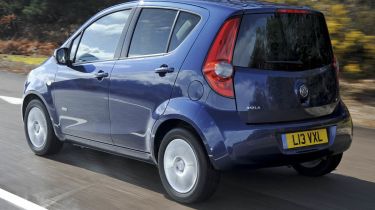Vauxhall Agila 1.2 Design
Sharp newcomer aims to erase memory of lacklustre predecessor.
Easy to drive, simple to park, affordable to own... that’s how Vauxhall describes its new city car. Of course, the same could have been said of the ungainly previous-generation Agila. That was labelled a mini-people carrier, but the idea never really took off in the UK. So it’s no surprise the latest model is far more stylish, and hopes to rival the likes of the Fiat Panda, plus larger cars such as the Nissan Note.
From the back, there’s a hint of the Japanese supermini-MPV, thanks to the vertical tailgate and the elongated light clusters built into the C-pillars. We’re big fans of the design, especially the rising waistline and angular rear windows, which along with the flared wheelarches and sharp nose give a sporty and distinctive profile.
It’s not identical to the Splash, as the front and back are different enough to provide the two with their own identities. In our opinion, the Suzuki is the less fussy car, and we prefer the simpler lines. Yet the Vauxhall certainly stands out with its teardrop headlights and chrome grille.
As with the Splash, the Agila hides its height well – it’s actually 50mm taller than the new Hyundai, but doesn’t look it. This has obvious benefits for rear passengers, with excellent head space. Surprisingly, legroom isn’t as generous as in the Korean car, despite the fact it’s 175mm longer overall – a figure of 640mm is 40mm down. Still, it’s well finished and the seats are very comfortable. The trouble is, Agila owners will have to make do with manual windows in the back – the i10 has electric operation all-round.
Used - available now

2017 Ford
Fiesta
38,600 milesManualPetrol1.2L
Cash £6,100
2016 Tesla
Model S
78,000 milesAutomaticElectric
Cash £18,999
2022 Volvo
XC40
17,576 milesAutomaticPetrol1.5L
Cash £25,999
2021 Kia
Sportage
44,151 milesManualDiesel1.6L
Cash £14,697Up front, there’s plenty of light and space, and tall drivers will find the cockpit more comfortable than the i10’s. The Vauxhall and Suzuki share identical interior designs, and the centre console looks similar to that in the Hyundai, with a high-set stereo and three rotary ventilation controls.
The layout is easy to get on with and we like the high-mounted gearlever, too, although the toy-like tone that accompanies the indicators can be annoying. While the boot isn’t what you’d call cavernous – it’s very shallow – with 225 litres it’s bigger than a MINI’s and on par with the i10’s.
Vauxhall buyers can specify a 1.0-litre petrol engine, but that only comes with Expression and Club models. A diesel is also available, although the 1.2-litre petrol in our test car is set to be the biggest seller. With 85bhp it offers decent pace and will happily keep up with motorway traffic, although it can get a little raucous at high revs.
Still, in town it’s more than adequate, and the free-revving nature means it’s great for nipping in and out of traffic. Comfort is a big strength – ride quality is excellent, with the supple suspension soaking up potholes on rough city streets. The steering is light, for easy parking, and while on the open road it can feel remote, this doesn’t detract from the enjoyable driving experience.
At more than £9,500, the Agila is the most expensive choice here, although it’s worth noting that our test car comes in flagship Design trim. The mid-range Club weighs in at £8,895, while the entry-level 1.0 Expression is £7,595 – that puts the Vauxhall more on a par with the i10. An automatic box can be specified for £1,000 extra.
Yet whichever Agila you go for, the equipment tally isn’t as generous as in the Splash. There are only four airbags, while stability control is a £400 option. We would have expected Vauxhall to offer this as standard, especially as it’s included in the Suzuki. Could this affect the final verdict?
Details
Price: £9,595
Model tested: Vauxhall Agila 1.2 Design
Chart position: 2
WHY: All-new Agila promises to represent a huge improvement on the first-generation model.
Economy
The lighter Agila was more economical than the near-identical Splash, returning 40.6mpg over our test route. That gives it a useful range of more than 400 miles. But this was some way short of Vauxhall’s claimed figure of 51.4mpg.
Residuals
The new Agila should prove a much better bet on the used car market than its predecessor. Our experts predict strong residuals of 42.9 per cent – which means that in three years’ time, the little Vauxhall will still be worth £4,116.
Servicing
With 500 outlets in the UK, Vauxhall’s network certainly has the quantity. But it needs to improve the quality of service: the firm came 23rd out of 32 in last year’s Driver Power dealer survey. Three check-ups on the Agila cost £442 – the least here.
Tax
None of these cars emits less than 120g/km of CO2 – a surprise given their small engines and low kerbweights. Yet this barely affects company car tax. Agila owners in the lower band will pay £317 a year – the most here, but not by much.







